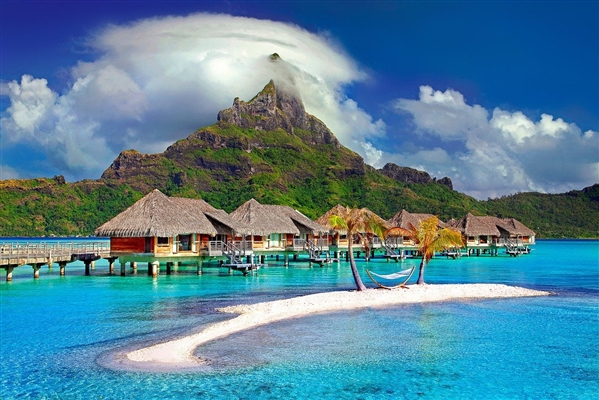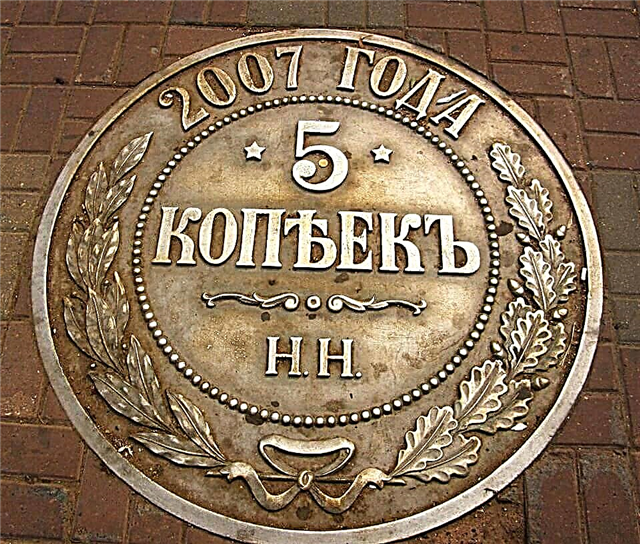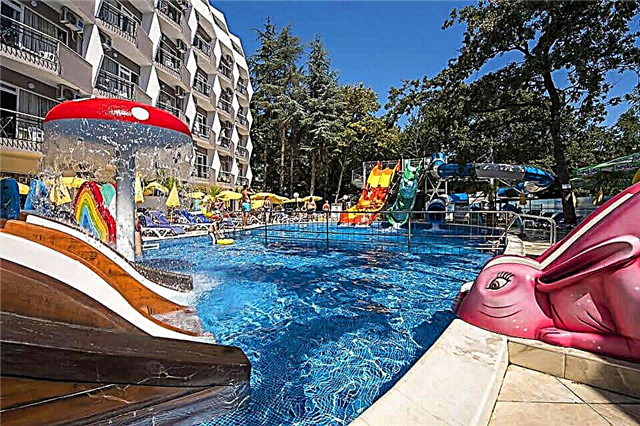Address: Kyrgyzstan, Issyk-Kul region
Area: 6236 km²
Maximum depth: 702 m
Coordinates: 42 ° 27'07.1 "N 77 ° 16'38.7" E
Since ancient times, the beauty of the Kyrgyz lake has been sung by the best poets of the East. The largest natural reservoir of this republic is famous for its clean transparent water, gentle banks and picturesque foothills, and its name is translated as "hot lake". A moderate maritime climate, mild winters and a large amount of heat that accumulates here during the summer months do not allow the lake to freeze during the cold season.

Lake Issyk-Kul from a bird's eye view
Records and features
Issyk-Kul lies at an altitude of 1609 m and therefore belongs to the largest mountain lakes in the world. However, this is not the only record of the Kyrgyz lake. Issyk-Kul is very large - the length of the reservoir is 182 km, and the width is 58 km. In terms of size, it is included in the 25 largest lakes in the world.
The maximum depth of the natural reservoir reaches 702 m, and the average depth is 278 m. The lake is closed-flowing - more than eight dozen small rivers flow into it. Due to this, the lake water has a slightly salty taste - its mineralization is 5.9 ‰. Another interesting feature of Issyk-Kul is fluctuations in the level of lake water. With a frequency of once every several decades, the water in the lake rises and falls. Therefore, the Kyrgyz have long believed that the lake breathes like a huge sleeping hero.
In terms of transparency, the Issyk-Kul water is second only to the Baikal water. More than 20 species of fish are found here, and more than half of them were brought to Kyrgyzstan and specially acclimatized for the mountain reservoir. Fishermen are well aware of the chebak and the Gegharkuni trout brought from the Armenian Lake Sevan. It is noteworthy that today trout weighing up to 17 kg or more are caught in Issyk-Kul.

Climate and resorts
The mild mountain-sea climate makes the air in the lake basin very transparent. It breathes well near the lake, and the number of hours of sunshine exceeds the Black Sea resorts. There are at least 300 sunny days in Issyk-Kul a year. The average temperature in the middle of winter ranges from -2 ... -6 ° С, and + 17 ° С at the height of summer. The amount of precipitation is unevenly distributed. More rain falls in the eastern part of the lake basin, and the western coast is considered drier.
Excellent climatic conditions have turned Issyk-Kul into a popular health resort and one of the most visited lakes in the world. From year to year, many people come here to improve their health from Kyrgyzstan, Kazakhstan, Russia and other countries. Sanatoriums and recreation centers are built in different places, but most of them are on the northern coast of the lake.
The treatment and recovery are facilitated by a wonderful climate, clean air, mineral waters and curative sulphide silt mud. Those tourists who want to relax cheaper do not buy vouchers to boarding houses and sanatoriums, but stay in the private sector, inexpensive mini-hotels or guest houses.

Issyk-Kul lake against the background of snow-capped mountains
On the northern coast, between the villages of Tamchi and Kurumbu, there are excellent sandy beaches, where there are many tourists from mid-June to late August. Many people call the village Bosteri and the resort town of Chonpon-Ata the most popular places for a beach holiday, and lovers of quiet places prefer to stay on the southern shore of the lake.
Leisure
The picturesque foothills of the Northern and Central Tien Shan attract fans of mountain tourism and mountaineering to Issyk-Kul. From the shores of the lake, ascent routes to the snow-capped ranges of Kungey-Alatau, Terskey-Alatau and Khan-Tengri begin. In the summer months, water tourism lovers float along the mountain rivers.
Alpine skiing is developed in the Issyk-Kul region. A modern ski center is located 7 km from the city of Karakol, at an altitude of 2300 m above sea level. This is the largest ski resort in Central Asia. The ski season here begins in November and lasts until April. Moreover, there is always enough snow for skiing, because the thickness of the snow cover on the slopes of the Tien Shan is from 1.5 to 2.5 m.

Yurts on the background of Issyk-Kul lake
Issyk-Kul looks interesting from above. Flights over the lake and the coast on hydro-hang gliders are carried out from Cholpon-Ata, and they turn into one of the most exciting adventures. It is very easy to make sure of the transparency of the lake water - you can perfectly see the bottom of the reservoir from a height of 250 m.
Scuba diving
Issyk-Kul is not a sea, so it is impossible to see colorful corals and schools of exotic fish in it. However, the clear water and local features have made diving one of the most popular mountain lake activities. The fact is that at the bottom of Issyk-Kul there are settlements and ancient settlements built 2.5 thousand years ago. Many of them are heavily covered with silt. But through the overgrown algae, you can still see the silhouettes of ancient ruins, and if you are successful, you can even find valuable artifacts from the past under water.

The purest water of Issyk-Kul
Diving centers are Cholpon-Ata and Bosteri. During the summer season, summer bases of diving clubs from Bishkek open in these places. From mid-June to the end of August, the temperature of the lake water makes it possible to organize sufficiently deep dives, therefore, training for beginners and underwater excursions for experienced divers is carried out in Issyk-Kul.
Reserve
While traveling to the largest lake in Kyrgyzstan, tourists can enjoy untouched nature and see many types of Red Book animals and plants. The Issyk-Kul Biosphere Reserve was established in 1948, and in 1991 was included by UNESCO in the World Network of Biosphere Reserves of the Planet. It covers 19.66 thousand hectares, which is 22% of the entire territory of the republic. The protected zone includes the lake water area, as well as the two-kilometer coastal zone around Issyk-Kul.

The reserve has 23 species of mammals, the rarest of which are snow leopards, deer and ibex. Near Issyk-Kul there are tolai hares, steppe ferrets, wild boars, gazelles, jerboas, jerboas, gerbils, badgers and weasels. The reserve is home to about 140 species of birds. Every year, several tens of thousands of waterfowl stay on the lake for wintering - swans, coots, red-nosed divers, teals, mallards and gray geese.
Natural and historical attractions
Not far from the southwestern shore of Issyk-Kul, there is an unusual Dead Lake or Tuz-Kul. You can get to it along a dirt road. The lake stretches for 1 km and is 0.5 km wide. Its picturesque shores are overgrown with rare vegetation, and the salt level in the water reaches 70%. Silt mud of this reservoir is considered curative. It is dark in color, so the reservoir is often called the Black Lake or Kara-Kol.

Bird's-eye view of the beach
On the southern coast, near the right bank of the Tamga River, you can see a stone block - Tamga Tash, which outwardly resembles a Kyrgyz yurt. The stone is surrounded three times by the words of the Buddhist mantra, written in Tibetan. Scientists believe that the text of the prayer formula "Om mane padme hum" was carved on a boulder in the 15th-17th centuries. There are three more stones with ancient ornate inscriptions within walking distance from Tamga Tash.
In the resort town of Cholpon-Ata, on an area of 42 hectares, there is an exposition of a popular open-air museum. It is called the Stone Garden or the Museum of Petroglyphs. Walking through the territory of the museum, tourists can see rock paintings from the 2nd millennium BC to the 4th century AD, cromlechs, border stone fences and tombstones. Travelers are advised to come here in the morning or evening hours, because in dim lighting, you can better see the drawings and inscriptions on the stones.
How to get there
The closest to the lake is the international airport of the capital of Kyrgyzstan - the city of Bishkek, where direct flights fly from the Russian capital, Yekaterinburg, St. Petersburg, Kazan, Surgut, Voronezh, Novosibirsk, Astana, Alma-Ata, Dushanbe, Tashkent and Osh.

Ferris wheel opposite the Dolphin boarding house with. Bosteri
From the airport you need to get to the Western Bus Station. This can be done by buses No. 153 or minibuses. The journey takes 30-40 minutes. From the bus station to the lake there are regular buses and minibuses that reach the settlements located on the shores of Issyk-Kul in 3-4 hours.











